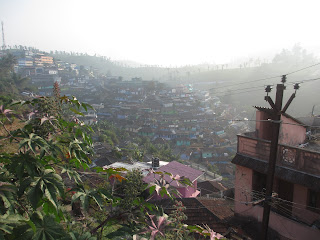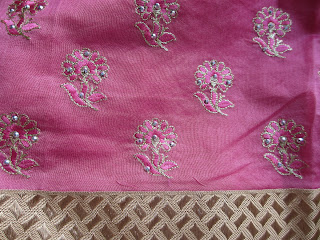Saturday morning saw me back at Quorn Country Crafts to purchase backing fabric and batting. I had it in my head to find a turquoise fabric, but there wasn't anything the right shade. Orange, I felt, would overpower the other colours. I looked at cream, but decided that might show the dirt too much. So I was left with the brown/beige option. I must've looked a bit daft, holding my quilt top up to the shelf to find a match...
Anyway, I found a rather lovely spotted beige which didn't look bad at all, so after a few mathematical equations (who knew it was so hard to work out how much you needed to buy for borders and backing?!) I had a metre and a half of fabric and the same of batting. Batting is the spongy layer that gives your quilt the lovely squishy feel when it's finished.
Sorted.
When I got home, I had a play with my new rotary cutter (SUCH a fab tool!) and discovered it will cut through four layers of fabric at once, though I can't cut in a straight line even using a proper quilting ruler. At least I had my borders; slightly wider for the top and bottom than for the sides.
Once they were sewn on, I could layer the pieces. Backing fabric face down, batting, then quilt top face up. I left quite a bit of backing and batting at the sides because I wasn't sure how much it would bunch once I started the actual quilting bit - as it turns out, I wasn't too far off from where I needed to be, so there wasn't much wastage.
Then I pinned everything together. Now, before I looked into this quilting lark, I hadn't realised the significance of the quilting - that is, the stitching which goes all over your patchwork. It's to keep the batting in place. If you didn't stitch across the patchwork, you'd probably end up with a lumpy quilt! So it's quite important at this stage to hold all the layers in place before you begin to stitch.
Then I stitched a ditch. This is a technical term, which means you stitch within the seams you've already sewn. I figured that, as I'd mastered straight lines on the sewing machine, I'd be better off doing that than trying to do diagonals or free hand curves. Actually, I'm not sure my vintage Singer will do anything free hand...
 |
| My first ditch, stitched! |
I sewed a quarter inch away from the seam on the first few squares - starting in the middle of the patchwork and moving out - and as I got further out, I realised I could use the width of the machine foot to get much closer - about an eighth of an inch. The ditches certainly got neater, I felt, as I made more of them.
Now, bearing in mind I'm not THAT au fait with the sewing machine or quilting as a technique, I discovered several things at this stage.
1. Remember I mentioned about the bobbin thread jumping out? Well, that was due to me not putting the bobbin in the right way round. It has to sit with the thread wound clockwise, not anticlockwise. Once I swapped the bobbin over, I had no more tension problems.
2. You have to try to start every new square's stitching with sides that are already stitched - and if you can, make sure that if you have to stitch from the outside in, you start on a side that's already got a ditch stitched or the fabric bunches up. (The quilt nearly went out of the window when I had unpicked the same square three times before I realised what might be causing the bunching...)
3. Even this small quilt takes a lot of managing on the machine. Most of my time was taken up by manoeuvring the quilt when I needed to turn the corners...
4. Stitching ditches makes lots of ends to tie off. Lots and lots and lots of ends... I pulled every one through to the back and tied them off in pairs before threading a needle and pulling them through the backing fabric to secure them. It was like being in needlework class, aged 11, all over again...
 |
| Just a few loose ends... |
I got all 42 ditches stitched by the end of Sunday, and today I stitched the outside edge to finish the quilt off. I probably didn't do it right - there are all sorts of ways of using binding to edge the quilt, but I went for simplicity. I wrapped the top layer over the batting, then folded the backing in on itself and sewed all the layers together. It took so long to fold and pin (and trim where necessary) that I forgot to take any photos of this stage. Suffice to say it was fiddly and took twice as long to pin as it did to sew. Some of the edges didn't end up exactly right, because the top layer moved slightly so the bottom layer shows a bit in places, but it's not too bad.
Last few ends to tie in and...voila!
One quilt. Finished size is 39"x 31" (99cm x 79cm) and it will be great I think for a cot or a lap quilt. I am very happy with it.
But now, I have to decide what to do with it.
As I said in my first patchworking post, the colours are lovely, but they don't fit with the decor in my home. And the reason I started this project was really just to learn how to make a quilt - I wasn't too worried about the end result, if that makes sense?
So, I think I shall see whether anyone would like to buy it. Not to make anything for myself - I would ask only for the material costs (£30). If there are no takers, then I shall donate it to a charity. If you're interested, drop me an email...
But now, job done. I really ought to get back to the writing.


















































